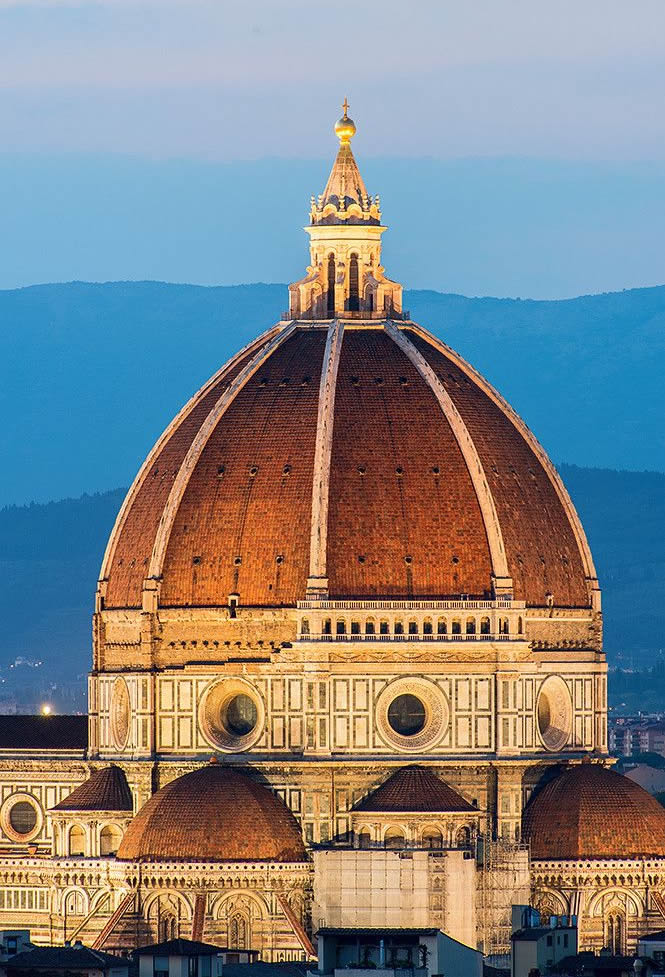 |
| Filippo Brunelleschi |
Born the son of a lawyer in Florence in 1377, Filippo Brunelleschi rejected his father’s choice of a law career and trained as a goldsmith and sculptor. After six years of his apprenticeship he passed the exam and officially became a master in the goldsmith’s guild.
During his apprenticeship, he was a student of Polo Pozzo Toscandli, a merchant and medical doctor, who taught him the principles of mathematics and geometry and how to use the latest technology. Goldsmithing gave him the opportunity to work with clocks, wheels, gears, and weights, a skill that would come in handy for an architect destined to design his innovative dome of the cathedral in Florence.
In 1401–02, he entered a competition for the design of the new Florence Baptistery doors, but he was defeated by another goldsmith and sculptor, Lorenzo Ghiberti. This failure led him to architecture in addition to his artistic career.
  |
In 1418 he entered another competition to design the dome of the Cathedral Maria del Fiore, (also known as the Duomo), in Florence. His design for the octagonal ribbed dome, not finished until 1434, is the work for which he is best known and one of his most important contributions to architecture and construction engineering. Brunelleschi designed special hoisting machines to raise the huge wood and stone elements into place.
He solved the problem of constructing a huge cupola (dome) without a supporting framework and invented a belt-like reinforcement of iron and sandstone chains to stabilize the outward thrusts at the base of the great dome. His innovative brick-laying techniques were refined in response to the requirements of the steep angles of the vaulting in the dome. It remains the largest masonry dome in the world.
In 1430 and again in 1432 Brunelleschi visited Rome with his friend, Donatello, where he became interested in Roman engineering, especially the use of vaulting and proportion. Influenced by Roman architecture, he used ancient principles in his projects, using Corinthian columns, geometrical balance, and symmetrical order.
 |
| the dome of the Cathedral Maria del Fiore |
Brunelleschi’s oeuvre includes the Ospedale degli Innocenti (Foundling Hospital, 1419–45), the reconstruction of San Lorenzo (1421–60), the Medici Chapel in San Lorenzo (1421), the New Sacristy at San Lorenzo (now known as the Old Sacristy; 1428), the Pazzi Chapel in the Cloisters of Santa Croce (1430), and Santo Spirito (1436).
These works renewed the appearance of Florence. His architectural works in other cities include the Ponte a Mare at Pisa, Palazzo di Parte Guelfa (1425), the unfinished Rotonda degli Angeli (1434), and the Pitti Palace (commissioned by Luca Pitti in 1440 when Brunelleschi was 60 years old) in Rome.
Brunelleschi’s design for the Ospedale degli Innocenti is mathematically based on repeated squares, and by a series of arches supported on columns—a motif later widely borrowed by renaissance architects. Brunelleschi often used the simplest materials: local gray stone (pietra serena) and whitewashed plaster.
   |
The sober, muted colors give an air of peaceful tranquility to the walls of Brunelleschi’s buildings. Brunelleschi reintroduced the pendentive dome (developed long before by the Byzantines) in the Old Sacristy. The arched colonnade from the Ospedale degli Innocenti is again repeated inside the Church of San Lorenzo.
After his death in 1446, Brunelleschi was buried in Santa Maria del Fiore in a tomb that, though it lay unrecognized for centuries, was identified in 1972. There is also a commemorative statue of the architect in the Piazza del Duomo, facing the cathedral. He was a well-known and widely respected designer during his lifetime, and his fame continued long after his death.